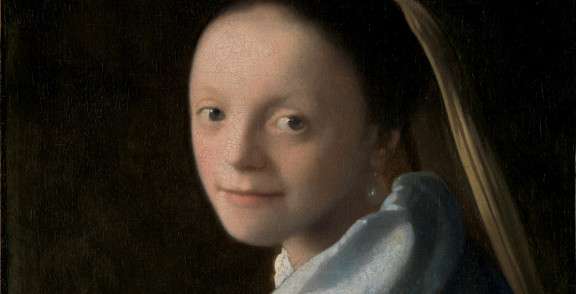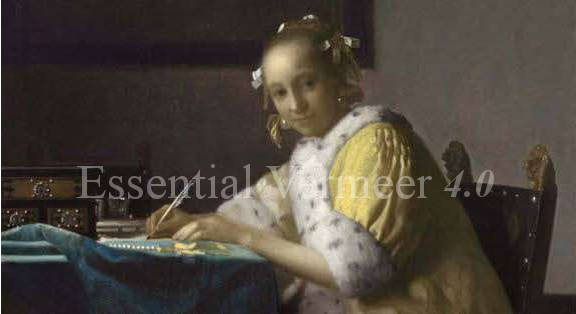No. 1. "A young lady weighing gold, in a box, by J. van der Meer of Delft, extraordinarily artful and vigorously painted" 155-0
The description of the painting no. 1 of the Dissius auction catalogue is unanimously believed to correspond to the Woman Holding a Balance of the National Gallery. Although we know nothing about the box in which the painting was kept, we do know that in the inventory of Jacob Dissius's house there were three "Vermeer's in boxes" in the front room.
Particularly precious paintings (or nudes, for motives of decorum) may have been protected from dust in such a manner. Curtains were commonly used for the same purpose and were often represented in Dutch interior paintings.
 >Young Woman at Her Dressing Table (with opened frame)
>Young Woman at Her Dressing Table (with opened frame) Frans van Mieris
1667
Oil on panel, 27 x 22 cm.
Gemäldegalerie Alte Meister, Staatliche Kunstsammlungen, Dresden
Another supposition1 is that the painting was originally a piece of a so-called peep-box or peep-show,2 an unusual device3 which served to create the most complete sense of visual illusion as possible. Carl Fabritius, Vermeer's contemporary, was known to have constructed such a device. by Samuel van Hoogstraten is conserved in near perfect state in the London National Gallery.

Woman Holding a Balance
c. 1662–1665
Oil on canvas, 42.5 x 38 cm.
National Gallery of Art, Washington D.C.
In any case, the painting no. 1 fetched a very high price (155 guilders) considering its dimension. The buyer was Isaac Rooleeuw, a Mennonite merchant and painter, (c. 1650–1710) who also purchased The Milkmaid now in the Rijksmuseum. Rooleeuw must have known very well exactly which Vermeer's he wished to acquire seeing that he was willing to pay such disproportionate prices for the pair. For five years the two works hung side-by-side at his home in Amsterdam, until Rooleeuw went bankrupt and the paintings were sold.
The Woman Holding a Balance is the only painting by Vermeer which can be traced in an unbroken line from the seventeenth century.
† FOOTNOTES †
- K. Bostrom, "Peep-show or Case?" in Kunsthistorische Mededeelingenvan het Rijksbureau Documentie 4, 1944, 21–24.
- Gifford Bomford, "Perspective, Anamorphosis, and Illusion: Seventeenth-Century Dutch Peep Shows," in Vermeer Studies, eds. Ivan Gaskell and Michiel Jonker, National Gallery of Art Washington D.C., New Haven and London: Yale University Press, 1998, 1998.
- from: "Samueal van Hoogstraten," Famous Dutch Painters from Dordrecht, Ancient Capital of Holland, http://geerts.com/Painters/painters10.htm. The peepshow is a rectangular box, the interior is painted on three sides, as well as on the top and bottom. The sixth side is open; originally light would have entered the box from this side, perhaps through specially treated paper stretched across it. The box would have been placed close to a window or illumination provided by a candle. There are peep-holes in the two shorter sides which provide the illusion of three-dimensional views of the interior of a house. Hoogstraten's box is an unusually elaborate example, decorated on the exterior with allegorical paintings which correspond to chapters in a theoretical book that the artist was to write later. The long side illustrates love of wealth as a motivation for the artist, who appears with a putto holding a cornucopia. Love of art and of fame are the subjects of the paintings on the short sides, while the top is decorated with an allegory of physical love, representing Venus and Cupid in bed, painted in anamorphic (distorted perspective) projection.
If you discover a  or anything else that isn't working as it should be, I'd love to hear it! Please write me at: jonathanjanson@essentialvermeer.com
or anything else that isn't working as it should be, I'd love to hear it! Please write me at: jonathanjanson@essentialvermeer.com



